The metal is usually the least expensive part of the diamond ring and is often given the least thought when purchased. Shoppers often tend to focus more on obtaining a great diamond and then forget to spend any time evaluating its setting.
Settings can come in all types of metals. Gold and platinum are the most popular for setting diamonds and precious gems. Most gold and platinum is alloyed with other metal to make it stronger. An alloy is a mixture of two or more metals formed by melting them together.
Yellow Gold
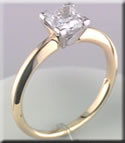 Yellow gold is the classic metal for jewelry and is one of the oldest metals to be fashioned by man. It is attractive in color and brightness, very durable, highly malleable and usually found in nature in a comparatively pure form. Yellow gold makes a good setting for slightly yellowish diamonds because it tends to mask the diamond’s yellowish tints.
Yellow gold is the classic metal for jewelry and is one of the oldest metals to be fashioned by man. It is attractive in color and brightness, very durable, highly malleable and usually found in nature in a comparatively pure form. Yellow gold makes a good setting for slightly yellowish diamonds because it tends to mask the diamond’s yellowish tints.
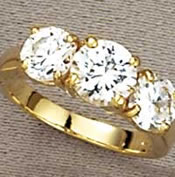 Yellow gold comes in all shades of yellow and personal taste usually dictates which hue to choose. Lighter (greener) yellow indicates more silver alloyed with the gold. Darker (pinker) yellow indicates more copper alloyed with the gold. No matter which gold color is created, the pure gold is always present in the correct percentage. Fine gold (pure) is 24 karats. For example, 18 karat gold will always have 75% pure gold while the rest is one or more alloys.
Yellow gold comes in all shades of yellow and personal taste usually dictates which hue to choose. Lighter (greener) yellow indicates more silver alloyed with the gold. Darker (pinker) yellow indicates more copper alloyed with the gold. No matter which gold color is created, the pure gold is always present in the correct percentage. Fine gold (pure) is 24 karats. For example, 18 karat gold will always have 75% pure gold while the rest is one or more alloys.
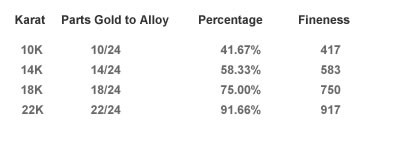
All jewelry is required by law to be stamped so consumers will know the quality of gold used. Jewelry made in North America is typically marked with the karat grade (10K, 14K, 18K, etc.). Jewelry made in Italy is typically marked with the “fineness” such as 417, 583, etc. If your jewelry does not have a karat grade stamped on it, check for a 3-digit fineness number.
Pure gold is a relatively soft metal so alloys are added for strength and durability. The higher the karat grades the more gold in the metal and the softer it is. Metal with a lower gold percentage tends to be stronger and harder but are not as yellow as higher karat grades.
White Gold
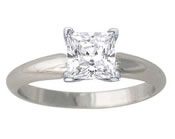 White gold is an alloy of gold and some white metals such as silver and palladium. White gold can be 18ct, 14ct, 9ct or any karat. For example, 18ct yellow gold is made by mixing 75% gold with 25% other metals such as copper and zinc. 18ct white gold is made by mixing 75% gold with 25% other metals such as silver and palladium. So the amount of gold is the same but the alloy is different.
White gold is an alloy of gold and some white metals such as silver and palladium. White gold can be 18ct, 14ct, 9ct or any karat. For example, 18ct yellow gold is made by mixing 75% gold with 25% other metals such as copper and zinc. 18ct white gold is made by mixing 75% gold with 25% other metals such as silver and palladium. So the amount of gold is the same but the alloy is different.
Traditionally nickel was used in white gold; however, nickel is no longer used in most white gold made today as nickel can cause reactions with some people.
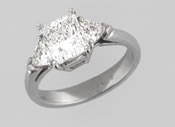 When white gold rings are new they are coated with another white metal called Rhodium. The rhodium plating is used to make the white gold look whiter. The natural color of white gold is actually a light grey color. The Rhodium is very white and very hard, but it does wear away eventually. Most local jewelers are able to re-rhodium plate jewelry for a nominal fee, usually $50 or less.
When white gold rings are new they are coated with another white metal called Rhodium. The rhodium plating is used to make the white gold look whiter. The natural color of white gold is actually a light grey color. The Rhodium is very white and very hard, but it does wear away eventually. Most local jewelers are able to re-rhodium plate jewelry for a nominal fee, usually $50 or less.
When the U.S. government declared platinum a strategic metal at the start of World War II, white gold was substituted because of consumer preference for platinum’s neutral color.
White gold is a lot less expensive than platinum because of its high content of alloys that are cheaper than gold. White gold is a good substitute for platinum because it is much less expensive than platinum. It is a more secure setting than yellow gold because the alloys that provide its whitish hue are stronger than those alloys that give yellow gold its strength and color. The rhodium plated white gold provides a much more scratch resistance surface than yellow gold.
Platinum
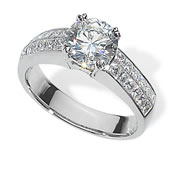 Platinum is a whitish metal that is rarer than gold and unlike gold it is used in jewelry in almost its pure form (approximately 95% pure). Platinum is extremely long wearing and is very white, so it does not always need to be rhodium plated like white gold. It is largely hypoallergenic and tarnish -resistant.
Platinum is a whitish metal that is rarer than gold and unlike gold it is used in jewelry in almost its pure form (approximately 95% pure). Platinum is extremely long wearing and is very white, so it does not always need to be rhodium plated like white gold. It is largely hypoallergenic and tarnish -resistant.
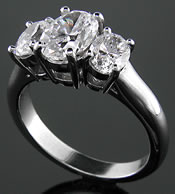 All platinum sold must be stamped with a common quality mark. These marks are usually Platinum, Plat, or Pt followed by the percentage of platinum used. For example, Pt1000 (pure platinum), Pt999 (999 parts per thousand platinum and one part other metal). Other common platinum alloys are: Pt950, Pt900 and Pt850. A jewelry item containing 950 parts platinum or better can be marked with only Platinum or Plat and is considered a high grade of platinum. The alloys used with platinum are copper, titanium, palladium, rhodium, ruthenium iridium and osmium. Higher amounts of palladium helps platinum take a whiter, brighter finish.
All platinum sold must be stamped with a common quality mark. These marks are usually Platinum, Plat, or Pt followed by the percentage of platinum used. For example, Pt1000 (pure platinum), Pt999 (999 parts per thousand platinum and one part other metal). Other common platinum alloys are: Pt950, Pt900 and Pt850. A jewelry item containing 950 parts platinum or better can be marked with only Platinum or Plat and is considered a high grade of platinum. The alloys used with platinum are copper, titanium, palladium, rhodium, ruthenium iridium and osmium. Higher amounts of palladium helps platinum take a whiter, brighter finish.
Platinum will resist breaks, chips and cracks better than gold. Because of its higher density and strength, platinum tends to retain its finish better than gold. However platinum scratches tend to be more noticeable than with gold. If a platinum item has a high polish finish, scratches are actually easier to spot because of the high contract between the polish and the spot. Platinum’s surface, when scratched will actually separate and make room for the scratch without loss of metal. This means that platinum does not lose the minuscule amount of metal that disappears when other precious metals are scratched. This explains why engravings last almost indefinitely on platinum while gold will be worn off in relatively short time.
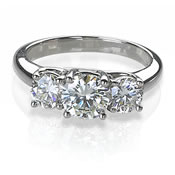 Platinum takes many more steps in the setting or resizing process. It also takes a different set of skills and special tools that many jewelry repair people to not have. Platinum has a much higher melting point than other precious metals and it can be easily contaminated if mishandled. Therefore you need a qualified and skilled craftsman to work on your platinum jewelry.
Platinum takes many more steps in the setting or resizing process. It also takes a different set of skills and special tools that many jewelry repair people to not have. Platinum has a much higher melting point than other precious metals and it can be easily contaminated if mishandled. Therefore you need a qualified and skilled craftsman to work on your platinum jewelry.
While it is very difficult to see the difference between platinum and rhodium plated white gold, platinum has a very different feel. Platinum is very dense and weighs over 60 percent more than the same item in 14 karat gold.
Platinum settings are about three times as expensive as 14 karat gold. Is platinum worth the additional expense? The answer is dependent on what the jewelry item and your budget. If you have a $2000 budget for a ring, it makes more sense to spend $110 for 14 karat gold than $300 for platinum since it leaves more dollar for a bigger and better diamond. If you are spending $10,000 on a diamond, the price difference between gold and platinum is a much smaller part of the total budget so platinum is probably the way to go. If you are getting a temporary setting for the diamond and planning on your gal getting the setting of her choice within a year, the 14 karat gold is the better choice.
Titanium
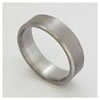 Titanium, first known as “Menachite,” is one of the most durable metals available today. It is so sturdy in fact, that it is used commercially in aircraft production. In recent years, titanium jewelry has become a hot trend, as titanium is a superior metal for jewelry simply because it will never tarnish, it is compatible with the human body, it does not cause any allergic reactions or skin discolorations, and it is incredibly durable, making it ideal for wedding rings or other such jewelry.
Titanium, first known as “Menachite,” is one of the most durable metals available today. It is so sturdy in fact, that it is used commercially in aircraft production. In recent years, titanium jewelry has become a hot trend, as titanium is a superior metal for jewelry simply because it will never tarnish, it is compatible with the human body, it does not cause any allergic reactions or skin discolorations, and it is incredibly durable, making it ideal for wedding rings or other such jewelry.
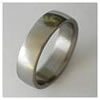 Titanium is a natural element found in small deposits all over the world. It is hypo-allergenic which means that it will not give any allergies to even the most sensitive skins. This is why titanium is widely used for implants in surgery. It is durable, very light in weight and takes on body heat instantly. Titanium will last a lifetime, but like all other metals it may scratch.
Titanium is a natural element found in small deposits all over the world. It is hypo-allergenic which means that it will not give any allergies to even the most sensitive skins. This is why titanium is widely used for implants in surgery. It is durable, very light in weight and takes on body heat instantly. Titanium will last a lifetime, but like all other metals it may scratch.
 Titanium is a “white” metal with a slight charcoal gray hue. Its natural color is darker and deeper than silver or white gold, and most comparable to platinum, in terms of color. It does however, have a slightly smoky hue to it, and can be polished to shine brightly, or it can be brushed to tone down the shine.
Titanium is a “white” metal with a slight charcoal gray hue. Its natural color is darker and deeper than silver or white gold, and most comparable to platinum, in terms of color. It does however, have a slightly smoky hue to it, and can be polished to shine brightly, or it can be brushed to tone down the shine.
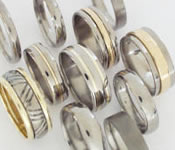 Bands made of titanium are often made with inlays of other metals including yellow gold, sterling silver and platinum. These metals contrast with titanium’s smoky gray color to produce unique designs.
Bands made of titanium are often made with inlays of other metals including yellow gold, sterling silver and platinum. These metals contrast with titanium’s smoky gray color to produce unique designs.
There is a wide variety of titanium grades and alloys available on the market today. The three most commonly used in jewelry making are Ti-6/4, which is aircraft grade titanium alloy, Ti-6/6/2, which is extra hard titanium, and finally CP 4, which is commercial pure titanium, grade 4. These three grades of titanium work well for jewelry, as they are very durable, lightweight, and cause no discoloration or allergic reaction to the human body.
Titanium is 4 times harder than stainless steel, 1/5 the weight of gold and has extremely high melting temperature (1800 °c).
Titanium is often marketed as being scratch-resistant, but our experience shows that with normal wear, titanium wedding bands will quickly begin to show small scrapes and scratches just like gold and platinum wedding bands. Although titanium is a very hard and durable metal, it can still be scratched by abrasive materials like rocks, sandpaper, and even hardened steel tools and utensils.
The colors on titanium occur when the surface oxide that forms reaches a specific thickness. Colors are not due to color present in the oxide, but are explained by a phenomenon called “optical interference”. In this phenomenon, two parallel reflecting surfaces exist: the upper surface which is variably transparent depending on oxide thickness, and the lower surface which is the true metal surface.
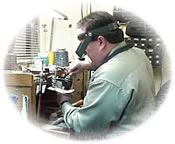 White light rays striking the metal surface enter the oxide film and reach the reflective interface between the metal and the oxide film. Light is broken up and refracted from the surface as multiple reflections. Differences in the oxide thickness cause the film to appear as different colors. The colors observed also appear on soap bubbles or oil floating on water. In nature this magical effect also occurs on shells, feathers, butterfly wings and beetles.
White light rays striking the metal surface enter the oxide film and reach the reflective interface between the metal and the oxide film. Light is broken up and refracted from the surface as multiple reflections. Differences in the oxide thickness cause the film to appear as different colors. The colors observed also appear on soap bubbles or oil floating on water. In nature this magical effect also occurs on shells, feathers, butterfly wings and beetles.
A major drawback is that due to the hardness of this metal it is not easy to work with and can take a heavy toll on machinery. Most bands do not carry intensely intricate designs for this reason – to get around this people often incorporate gold into the design which is more workable. For this same reason you will find that not all jewelers are equipped to cut this hard metal which is a problem for resizing. Because of this unique nature, re-sizing these rings is nearly impossible; therefore, great care must be taken when sizing your finger. It is possible to slightly increase a titanium ring’s size by removing a small amount of material from the inside surface, but it isn’t possible to make it smaller.
Even the process of extracting the metal requires a lot of energy and is very labor intensive. So even though it is a common metal (4th most common on this earth) it is not as cheap as you would think because it requires all this hard work.
